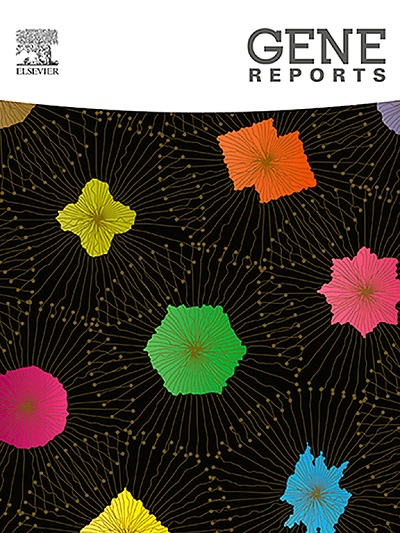Association of thrombophilic genes (MTHFR, MTR and MTRR) polymorphisms and homocysteine level in relation to the increased risk of thrombosis among COVID-19 patients
IF 1
Q4 GENETICS & HEREDITY
引用次数: 0
Abstract
Background
Patients with COVID-19 have an increased risk of thrombosis and coagulopathy. Homocysteine, an amino acid essential to coagulation, is thought to be involved in such conditions, as its level is mediated by the presence of some single nucleotide polymorphisms (SNPs) in certain genes including MTHFR, MTR and MTRR.
Aim
The current study aimed to assess the significant role of MTHFR (C677T and A1298C), MTR A2756G and MTRR A66G SNPs as risk factors for thrombosis among Egyptian COVID-19 patients and their effect on homocysteine level.
Subjects and methods
This case-control study was carried out on 90 Egyptian COVID-19 cases, divided into 45 non-complicated cases and 45 complicated cases with thrombosis, in addition to 80 healthy control individuals. DNA was isolated from blood samples of all the participants. The genotyping was performed using real-time PCR; in addition, serum homocysteine level was estimated.
Results
The MTHFR (C677T and A1298C), MTR A2756G and MTRR A66G variants revealed a significant higher risk of thrombosis under different genetic models including the homozygous comparison of the co-dominant (20 % vs. 2.3 %, OR = 15.88, p = 0.007), the dominant (62.2 % vs. 33.3 % OR = 3.29, p = 0.006) and the allelic models (41.1 % vs. 17.8 %, OR = 3.2, p < 0.001) for MTHFR C677T and also the dominant (77.8 % vs. 51.1 %, OR = 3.3, p = 0.008) and the allelic models (52.2 % vs. 31.1 %, OR = 2.4, p = 0.004) for MTHFR A1298C. In addition, the heterozygous comparison of the co-dominant (60 vs. 11.1, OR = 12.7, p < 0.001), the dominant (62.2 % vs. 11.1 %, OR = 13.1, p < 0.001) and the allelic models (32.2 % vs. 5.6 %, OR = 8.08, p < 0.001) for MTR A2756G and the heterozygous and homozygous comparisons of the co-dominant model [(53.3 % vs. 31.1 %, OR = 3.4, p = 0.03) and (13.4 % vs. 2.2 %, OR = 12.0, p = 0.049), respectively], the dominant (66.4 % vs. 33.3 %, OR = 4.0, p = 0.001) and the allelic models (40 % vs. 17.8 %, OR = 3, p = 0.001) for MTRR A66G. Moreover, MTHFR (C677T and A1298C), MTR A2756G, and MTRR A66G variants were also associated with high levels of serum homocysteine (p = 0.045, 0.001, 0.005 and 0.039, respectively). The homocysteine level was related to the disease severity by its correlation with higher LDH (rs = 0.49, p < 0.001), CRP (rs = 0.44, p < 0.001), IL-6 (rs = 0.46, p < 0.001) and D-dimer (rs = 0.66, p < 0.001) levels. The multivariate regression analysis showed that homocysteine and the dominant models of MTHFR (C677T and A1298C), MTR A2756G and MTRR A66G were independent predictors of susceptibility to thrombosis among COVID-19 patients [(OR = 1.02, p = 0.007), (OR = 1.15, p = 0.043), (OR = 1.2, p = 0.024), (OR = 1.42, p < 0.001), (OR = 1.19, p = 0.021), respectively].
Conclusion
MTHFR (C677T and A1298C), MTR A2756G, and MTRR A66G gene variants were associated with high homocysteine and D-dimer levels that carried a risk for thrombosis among COVID-19 patients and associated with the disease progression.
嗜血栓基因(MTHFR、MTR 和 MTRR)多态性和同型半胱氨酸水平与 COVID-19 患者血栓形成风险增加的关系
背景COVID-19 患者罹患血栓和凝血病的风险增加。同型半胱氨酸是凝血所必需的一种氨基酸,被认为与此类病症有关,因为其水平受某些基因(包括 MTHFR、MTR 和 MTRR)中某些单核苷酸多态性(SNPs)的影响。本研究旨在评估 MTHFR(C677T 和 A1298C)、MTR A2756G 和 MTRR A66G SNPs 作为埃及 COVID-19 患者血栓形成风险因素的重要作用及其对同型半胱氨酸水平的影响。研究人员从所有参与者的血液样本中分离出 DNA。结果 MTHFR(C677T 和 A1298C)、MTR A2756G 和 MTRR A66G 变体显示,在不同的遗传模式下,血栓形成的风险显著升高,包括同显性变体的同型比较(20 % vs. 2.3 %,OR = 15%)。2.3 %,OR = 15.88,p = 0.007)、显性(62.2 % vs. 33.3 %,OR = 3.29,p = 0.006)和等位基因模型(41.1 % vs. 17.8 %,OR = 3.2,p < 0.001),以及 MTHFR A1298C 的显性模型(77.8% vs. 51.1%,OR = 3.3,p = 0.008)和等位基因模型(52.2% vs. 31.1%,OR = 2.4,p = 0.004)。此外,MTR A2756G 的共显模式(60 vs. 11.1,OR = 12.7,p < 0.001)、显性模式(62.2 % vs. 11.1 %,OR = 13.1,p < 0.001)和等位基因模式(32.2 % vs. 5.6 %,OR = 8.08,p < 0.001)的杂合子比较,以及共显模式的杂合子和等位基因比较[(53.3 % vs. 31.1 %,OR = 3.4,p = 0.03)和(13.4 % vs. 2.2 %,OR = 12.0,p = 0.049)],MTRR A66G的显性模型(66.4 % vs. 33.3 %,OR = 4.0,p = 0.001)和等位基因模型(40 % vs. 17.8 %,OR = 3,p = 0.001)。此外,MTHFR(C677T 和 A1298C)、MTR A2756G 和 MTRR A66G 变体也与血清同型半胱氨酸水平高有关(p = 0.045、0.001、0.005 和 0.039)。同型半胱氨酸水平与疾病严重程度有关,因为它与较高的 LDH(rs = 0.49,p < 0.001)、CRP(rs = 0.44,p < 0.001)、IL-6(rs = 0.46,p < 0.001)和 D-二聚体(rs = 0.66,p < 0.001)水平相关。多变量回归分析显示,同型半胱氨酸和 MTHFR(C677T 和 A1298C)、MTR A2756G 和 MTRR A66G 的显性模型是 COVID-19 患者血栓形成易感性的独立预测因子[(OR = 1.02,p = 0.007)、(OR = 1.15,p = 0.043)、(OR = 1.2,p = 0.024)、(OR = 1.结论MTHFR(C677T和A1298C)、MTR A2756G和MTRR A66G基因变异与高同型半胱氨酸和D-二聚体水平相关,而高同型半胱氨酸和D-二聚体水平在COVID-19患者中具有血栓形成风险,并与疾病进展相关。
本文章由计算机程序翻译,如有差异,请以英文原文为准。
求助全文
约1分钟内获得全文
求助全文
来源期刊

Gene Reports
Biochemistry, Genetics and Molecular Biology-Genetics
CiteScore
3.30
自引率
7.70%
发文量
246
审稿时长
49 days
期刊介绍:
Gene Reports publishes papers that focus on the regulation, expression, function and evolution of genes in all biological contexts, including all prokaryotic and eukaryotic organisms, as well as viruses. Gene Reports strives to be a very diverse journal and topics in all fields will be considered for publication. Although not limited to the following, some general topics include: DNA Organization, Replication & Evolution -Focus on genomic DNA (chromosomal organization, comparative genomics, DNA replication, DNA repair, mobile DNA, mitochondrial DNA, chloroplast DNA). Expression & Function - Focus on functional RNAs (microRNAs, tRNAs, rRNAs, mRNA splicing, alternative polyadenylation) Regulation - Focus on processes that mediate gene-read out (epigenetics, chromatin, histone code, transcription, translation, protein degradation). Cell Signaling - Focus on mechanisms that control information flow into the nucleus to control gene expression (kinase and phosphatase pathways controlled by extra-cellular ligands, Wnt, Notch, TGFbeta/BMPs, FGFs, IGFs etc.) Profiling of gene expression and genetic variation - Focus on high throughput approaches (e.g., DeepSeq, ChIP-Seq, Affymetrix microarrays, proteomics) that define gene regulatory circuitry, molecular pathways and protein/protein networks. Genetics - Focus on development in model organisms (e.g., mouse, frog, fruit fly, worm), human genetic variation, population genetics, as well as agricultural and veterinary genetics. Molecular Pathology & Regenerative Medicine - Focus on the deregulation of molecular processes in human diseases and mechanisms supporting regeneration of tissues through pluripotent or multipotent stem cells.
 求助内容:
求助内容: 应助结果提醒方式:
应助结果提醒方式:


